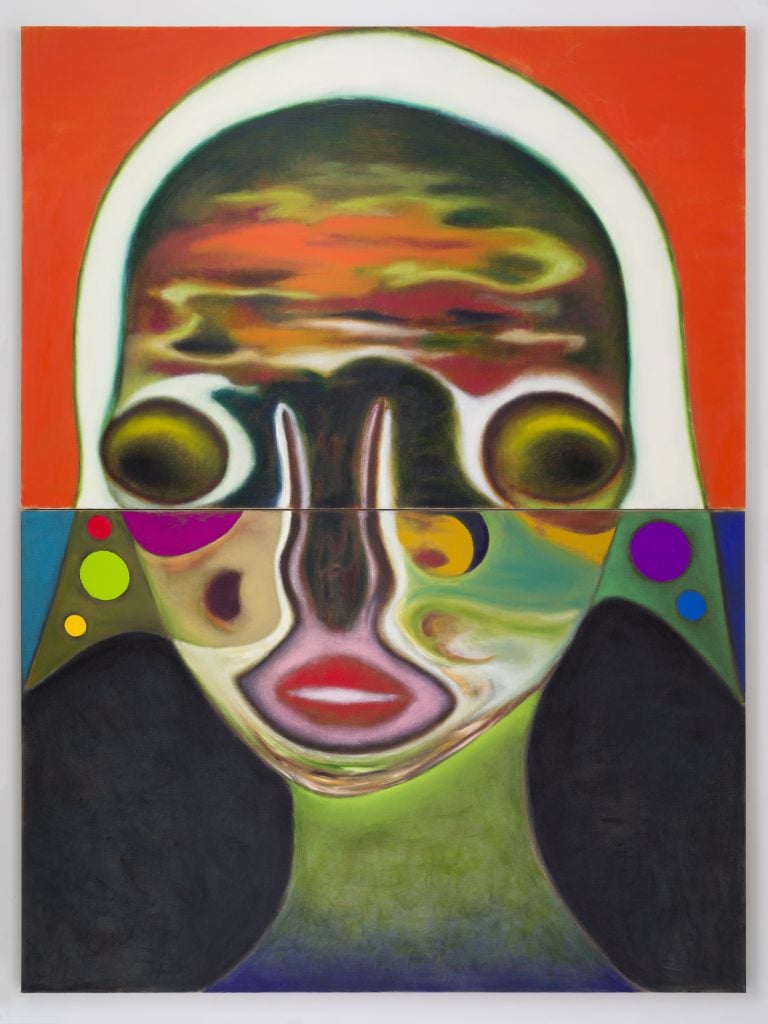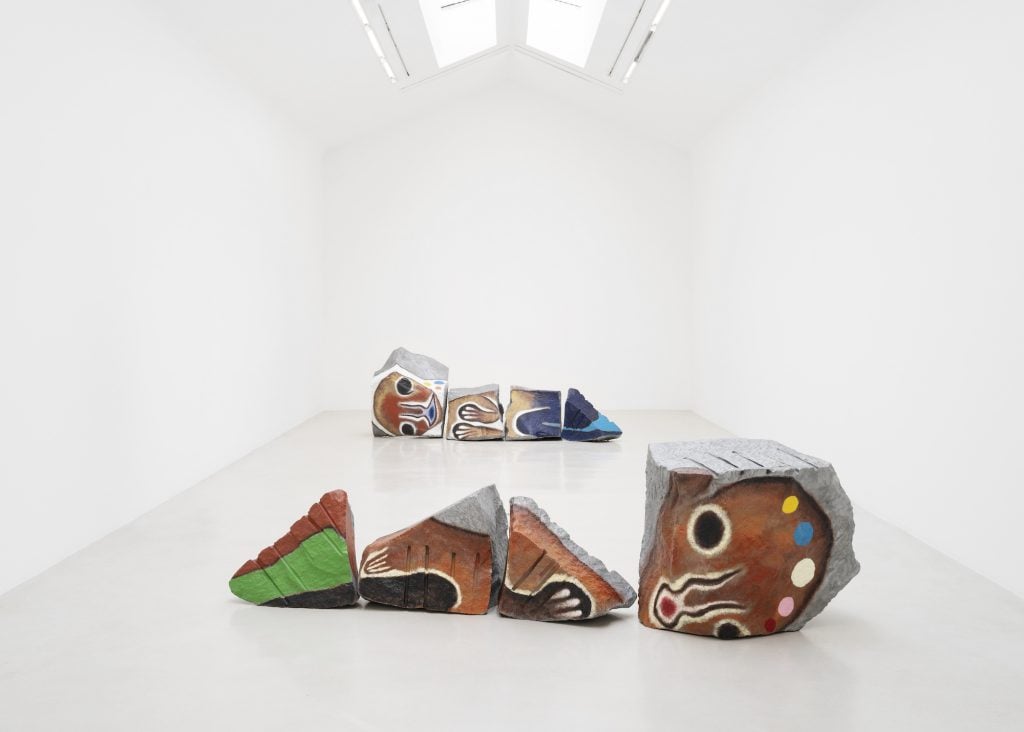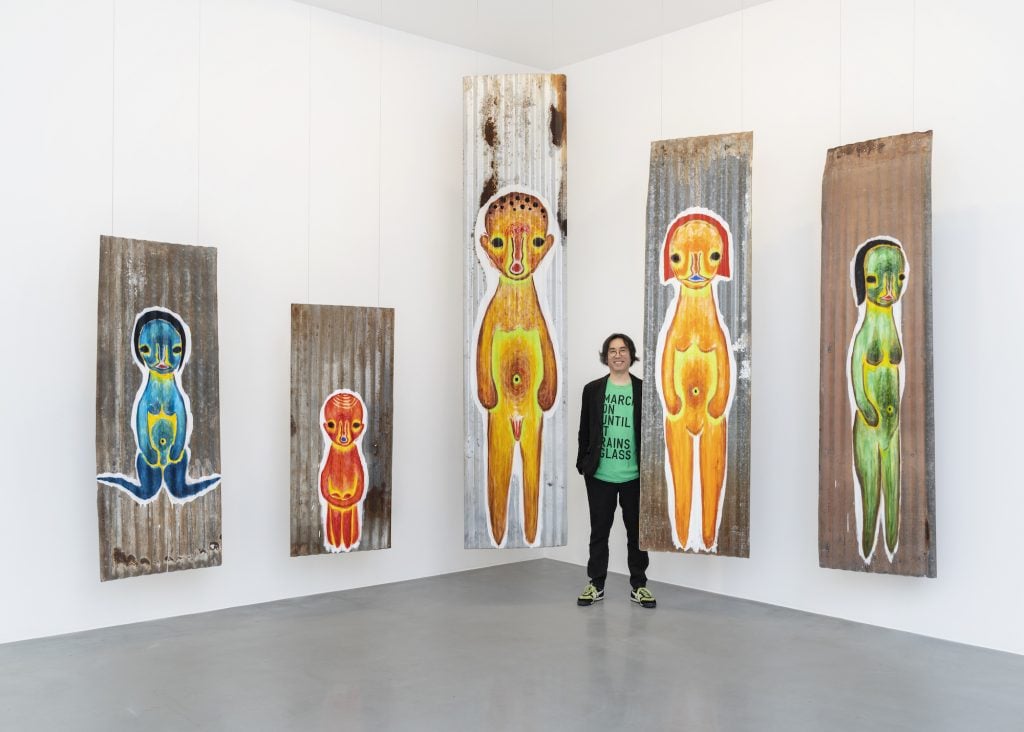I felt a little delirious walking into Izumi Kato’s studio. When I opened the door of his humble setup in a residential neighborhood of Northern Tokyo, I was met with the sight of an in-progress diptych featuring one of the beguiling metamorphic creatures characteristic of Kato’s practice. A combination of the smell of oil paint, my jet lag, and Tokyo’s scorching summer temperatures made me wonder whether this alien-like figure hadn’t just stirred in response to my entrance.
Kato has been based here, near the Tokyo University of the Arts, for the past five years, while also keeping another studio in Hong Kong. During that time, his career has been experiencing something of a lift-off. If you take auction sales as an indicator, his work went from bringing in $344,372 in 2018 to more than $3 million so far in 2023 alone.
Kato’s embryonic figures—painted with his fingers directly onto canvases, as well as on wood, textiles, and found objects such as rocks he reels in while out fishing—have won him something of a cult following, particularly among Chinese-speaking collectors.
But now, Kato appears to be breaking out more globally. Earlier this year, a crowd of curious observers at Frieze New York was drawn to a group of his enigmatic works occupying a corner of Perrotin’s booth. Studious Parisians flocked to an exhibition at the gallery’s signal space earlier this summer, and in London, sneakerheads are lining up to lay eyes on some pint-sized humanoid sculptures inhabiting pairs of shoes at the flagship store of Japanese shoe retailer Onitsuka Tiger.

Izumi Kato, Untitled (2023). ©Izumi Kato 2023. Photographer: Kei Okano. Courtesy of the artist and Perrotin.
Kato was born in 1969 in Shimane Prefecture, to the west of the Japanese peninsula. Originally having aspirations of becoming a musician, he only took up art at the age of 30, graduating from the Department of Oil Painting at Musashino University in 1992. That, in addition to his mid-career lift-off, makes him something of a late bloomer.
As we sat in his studio, we were surrounded by plastic models, a childhood hobby he revived during lockdown, and which inspired his latest series of “parasitic plastic models” adorning his sculptural pieces.
Soft vinyl and plastic toys were popular during his childhood, growing up as part of the post-war boom of children in Japan. “We played with plastic models and soft vinyl,” he said. “And if you turned on the TV, you would see them animated with special effects.”
The mysterious bulgy-eyed protagonists of his work may recall at once pre-historic cave paintings and the futuristic stuff of science fiction, but curators have rooted his practice in the Shinto belief that everything contains a spirit. This narrative has appealed to the market too. Odile Chen, the head of Taiwanese auction house Ravenel’s international art department, said that a fascination with Japanese cultural heritage, “particularly its traditional animism,” partly explains his fanbase in China, Hong Kong, and Taiwan, where stories about mythical creatures, gods, and monsters “have the power to captivate audiences of different generations in the Chinese community.”
Kato himself, on the other hand, seemed to offer a more abstracted vision of spiritualism when speaking of his painting process. “The feeling I have when I paint on stone is that I am painting on something that other people have already created, so it’s more of a collaboration,” he said.

Installation views of Izumi Kato’s solo show at Perrotin Paris, 2023. Photo: Claire Dorn. Courtesy of the artist and Perrotin. © Izumi Kato, 2023.
While contemporary Japanese art has been a growing segment of the international auction market, it is usually driven by an appetite for artwork by the likes of Takashi Murakami and Yoshitomo Nara, which take inspiration from anime and manga cartoons, and the insatiable appetite for “kawaii” or “cute” painting, which has only grown as the material circumstances of the world around us have gotten darker. Kato’s work stands apart from these examples; while there are some shared visual elements, he is making more mystical work with a darker undertone. And unlike some of his contemporaries, he’s not concerned with world-building, or painting recognizable characters. Rather he thinks the soft, half-formed creatures are more like expressions of consciousness, which is still being molded before your eyes. “It’s more of a compositional expression, I’m not trying to paint a figure at all,” he said.
Despite being similar in age to Murakami and Nara, Kato emerged in what is being dubbed a “post-Superflat” generation of artists, due to his late entry to the art world.
“At art school, they taught us how to use paint, but were lacking in the bigger social context of the art world,” he said. Instead, the major turning point for his career came years after he graduated, in 2007, after he was discovered by curator Robert Storr. “He’s the one who opened the door for me to the real global art world,” Kato said of Storr, who was artistic director of that year’s Venice Biennale and chose works on the spot to be included in the prestigious exhibition.

Izumi Kato. ©Photo: Claire Dorn. Courtesy Perrotin.
“When I went to Tokyo before the 2007 biennale, ‘cute’ Japanese art was everywhere,” Storr told me. “So Izumi Kato stood out from the crowd because his images seemed edgier, and not so eager to please.” Storr acknowledges that Kato’s archetypes have a similar kind of graphic quality to some of what his contemporaries, including Yoshitomo Nara, were marking at the time, but that they had a very different mood, being “neither bright and sunny nor childlike but frequently dark and mutable if not disturbingly ‘mutant.’”
Venice marked Kato’s first time showing outside of Japan. After that, Kato’s work immediately started to sell better both inside and outside of the country. He gained commercial representation with the esteemed Tokyo gallery SCAI the Bathhouse. “From that point, I was able to make a living as an artist,” he said. It was around then that his secondary market also began to take off. His work, which had never appeared at auction before 2006, brought in $289,028 in 2008, across 13 works.
Another pivot came a few years later when he started working with Perrotin, first exhibiting with the international heavyweight gallery in 2014. “It was the first time I started working with a proper international, commercial gallery. I was able to interact with artists from abroad like Othoniel from Paris, and meeting them was another occasion where the world felt expanded to me,” he said.
Kato’s work slid past the symbolic million-dollar mark when his $1.5 million auction record was set for an untitled triptych at a Phillips and Poly Auction sale in Hong Kong in November 2021. Today, on the primary market, Kato’s large paintings are priced between $250,000 and $300,000, while small sculptures can be acquired for between $25,000 and $35,000.

Izumi Kato, Untitled (2023). ©Izumi Kato 2023. Photographer: Kei Okano. Courtesy of the artist and Perrotin.
Though he is under no illusions about the upsides of commercial success (“We have to earn a living and money talks”) Kato maintains a sort of unbothered attitude towards his career. While the market’s appetite for cutesy characters and creators world-building through their art, Kato isn’t interested in devolving into repetitive characters, becoming an “influencer,” or creating a brand. “I don’t even think my style is firmly or completely established yet,” he shrugged when I asked him about this. “I might actually destroy it or change it in the future.”
For now, Kato is hoping for more museum exhibitions and engagement with his work outside of the market. “I know you need both academic work and the commercial side to grow together to be successful,” he said. “At the moment, the commercial market is stronger, but I hope some more art professionals pay attention to the work.”
“Parasitic: Onitsuka” is on view at Onitsuka Tiger London flagship, Tiger Gallery, 249-251 Regent St, Mayfair, London W1B 2EP, United Kingdom, June 17–September 22, 2023.













